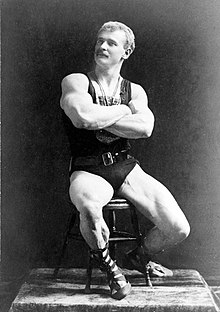尤金·山道
| Eugen Sandow | |
|---|---|
 | |
| 出生 | Friedrich Wilhelm Müller 1867年4月2日 普魯士王國柯尼斯堡 |
| 逝世 | 1925年10月14日(58歲) 英格蘭倫敦肯辛頓 |
| 墓地 | Putney Vale Cemetery |
| 別名 | Eugene Sandow[1] |
| 身高 | 175厘米(5英尺9英寸) |
| 配偶 | Blanche Brooks(1896年結婚) |
| 兒女 | 2 |
尤金·山道(Eugen Sandow;1867年4月2日—1925年10月14日),本名弗里德里希·威廉·穆勒(Friedrich Wilhelm Müller ,德語:[ˈfʁiːdʁɪç ˈvɪlhɛlm ˈmʏlɐ]),是一名普魯士健美運動員,號稱現代健美之父[2]。1901年,他倫敦的皇家阿爾伯特音樂廳舉辦了世界上第一個大型健美比賽,與阿瑟·柯南·道爾等一起擔任評委。 [3]
生平
[編輯]他於1867年4月2日出生於普魯士王國柯尼斯堡(今加里寧格勒)的一個猶太人家庭。他的父親是德國人,而他的母親是俄羅斯血統[4]。雖然他的父母都出生於猶太家庭,但後來都成為路德宗信徒,也希望他成為一名路德宗牧師[5]:6[6][7]。為避免服兵役,他於1885年離開普魯士遊歷歐洲,曾加入馬戲團,並取了化名尤金·山道。
在布魯塞爾,他參觀了路德維格·德拉克(Ludwig Durlacher)的健身房[8],並受到後者賞識和指導,讓他前往倫敦參加大力士比賽,由此出名。
小弗洛倫茨·齊格菲爾德想在芝加哥舉行的1893年芝加哥哥倫布紀念博覽會上僱傭他進行表演[9],但之前莫里斯·格勞(Maurice Grau)已經簽下山道[10],每周支付1000美元。齊格菲爾德雖然給不了那麼多,但同意以總收入的10%作為補償[10]。

1894年,愛迪生影業拍攝了以他為主角的三部短片《山道》(Sandow)[11]。他開設了自己的健身房「Sandow Institute」[12],1898年,他創辦月刊《山道體育雜誌》(Sandow's Magazine of Physical Culture),隨後又出版了不少體育類書籍,並創造了「body-building」(健美)一詞[13]。
1901年,山道在倫敦皇家阿爾伯特音樂廳舉辦了世界上第一場大型健美比賽。會場人滿為患。主持比賽的三位評委是雕塑家查爾斯·貝內特·勞斯、作家阿瑟·柯南·道爾和山道本人。[14]
1902年,山道在紐約市的舉重比賽中被凱蒂·布魯姆巴赫擊敗。這場勝利後,布魯姆巴赫給自己改了姓「Sandwina」(Sandow一名的女性化)。[15][16]
他週遊世界,去過南非、印度、日本、澳大利亞、新西蘭等。從1909年開始,他自費為英國陸軍預備役部隊新兵提供訓練,使他們達到體能標準。[17]
去世
[編輯]
山道於1925年10月14日在倫敦肯辛頓的家中去世,當時報道稱他死於腦出血,享年58歲[1][19]。據稱,這是由於他兩三年前在沒有幫助的情況下,用力將一輛遭遇車禍的汽車從溝里抬出來所致[20]。其死亡報告顯示死因為主動脈瘤,但其實他沒有經過屍檢[20]。
應妻子的要求,桑多安葬在帕特尼谷公墓(Putney Vale Cemetery),未樹立墓碑,傳聞這是因為他婚後出軌。但她的妻子對原因一直避而不談[20]。2002年,他的墓碑才由仰慕者樹立起來,2008年由其後代重新立碑[21]。
個人生活
[編輯]山道於1894年與曼徹斯特攝影師沃里克·布魯克斯(Warwick Brooks)的女兒布蘭奇·布魯克斯結婚[22],育有兩個女兒[23][24]。

他在倫敦肯辛頓荷蘭公園大道(Holland Park Avenue)的家是他的崇拜者、一個印度商人(Dhunjibhoy Bomanji)1906年贈與的,後者因為採用了他的鍛煉方法而改善了身體健康。[25][26][27]
作品
[編輯]- "How to Preserve Health and Attain Strength", Cosmopolitan, vol. XVII, no. 2, June 1894, pp. 169-176.
- Sandow's System of Physical Training (1894)
- Sandow on Physical Training (1894)
- Strength and how to Obtain It (1897)
- Sandow's Magazine of Physical Culture (1898–1907)
- Body-Building
- Strength and Health
- The Construction and Reconstruction of the Human Body (1907)
- Life is Movement (1919)
參考文獻
[編輯]- ^ 1.0 1.1 Death of Sandow. Time magazine. 26 October 1925 [2009-02-19]. (原始內容存檔於19 February 2012).
As it must to all men, Death came last week to Eugene Sandow, aged 58, chest expansion 14 inches.
- ^ Strength and How to Obtain It (頁面存檔備份,存於互聯網檔案館)
- ^ Louise Maher. The Mighty Sandow: How the world's strongest man wowed Australian audiences in 1902. ABC Radio. 29 Apr 2015 [2023-04-07]. (原始內容存檔於2023-04-08).
- ^ Baader, Benjamin Maria; Gillerman, Sharon; Lerner, Paul. Jewish Masculinities. Indiana University Press. 2012 [2023-04-07]. ISBN 9780253002136. JSTOR j.ctt16gz5c0. (原始內容存檔於2023-04-07).
- ^ Chapman, David L. Sandow the Magnificent: Eugen Sandow and the Beginnings of Bodybuilding. Sport and society. University of Illinois Press. 1994: 6 [27 January 2019]. ISBN 978-0-252-02033-9. OCLC 538245261. "Adam hints at the quarrel by reporting that Sandow's parents at first wanted their son to become a Lutheran minister, but later relented when it became obvious that he had no inclinations in that field."
- ^ Full text of "Sandow on physical training : a study in the perfect type of the human form". 1894.
- ^ Sandow, Eugen; Adam, G. Mercer. Sandow on physical training: a study in the perfect type of the human form. New York : J. S. Tait. 1 January 1894.
- ^ Louis Attila. Legendary Strength. 29 October 2013 [2014-08-08]. (原始內容存檔於2022-10-05).
- ^ Eugen Sandow. Encyclopædia Britannica. [2009-02-19]. (原始內容存檔於2015-05-07).
At the 1893 World's Columbian Exposition in Chicago he joined Florenz Ziegfeld's Trocadero Company and toured the continent for several years. Ziegfeld's Follies and his glorification of the American girl were inspired in part by his earlier successful showcasing of Sandow. Noted physical educator Dudley Sargent of Harvard University examined Sandow and judged him to be the finest specimen of manhood he had seen. By the time he left the United States, Sandow's name was a household word, and he had earned more than a quarter million dollars.
- ^ 10.0 10.1 Florenz Ziegfeld Dies in Hollywood After Long Illness. The New York Times. Associated Press. 23 July 1933 [2009-02-19]. (原始內容存檔於2009-10-15).
In New York the younger Ziegfeld knew Maurice Grau, grand opera impresario, had under contract Eugene Sandow. The "perfect man" Mr. Grau esteemed as worth $1,000 a week. Mr. Ziegfeld could not guarantee anybody $1,000 a week and so offered 10% of the gross. The deal was made and Sandow went to the World's Fair.
- ^ Souvenir Strip of the Edison Kinetoscope (Sandow, the Modern Hercules). Film Threat. 11 April 2008 [2008-04-20]. (原始內容存檔於2023-04-09).
- ^ Plaque to father of body-building. BBC. 16 February 2009 [2009-02-19]. (原始內容存檔於2023-04-09).
Fitness pioneer Eugen Sandow devised the first major body-building contest, which was held at the Royal Albert Hall in 1901. Sandow opened a gym, the Institute of Physical Culture, and performed on the stage all over the world. The plaque was unveiled at 161 Holland Park Avenue, where he lived from 1906 until he died at aged 58 in 1925.
- ^ Patrick Scott, 'Body-Building and Empire-Building: George Douglas Brown, The South African War, and Sandow's Magazine of Physical Culture, Victorian Periodicals Review, 41:1 (2008), pp. 78–94.
- ^ Eugen Sandow: Bodybuilding's Great Pioneer by David Chapman – Author of 'Sandow the Magnificent – Eugen Sandow and the Beginnings of Bodybuilding' 互聯網檔案館的存檔,存檔日期2010-03-25.
- ^ Steve Ward. Beneath the Big Top: A Social History of the Circus in Britain. Pen and Sword. 2014: 163–164. ISBN 9781783030491.
- ^ The Great Sandwina, Circus Strongwoman and Restaurateur. 26 December 2017 [7 October 2018]. (原始內容存檔於2023-04-09).
- ^ Oxford Dictionary of National Biography 48. Oxford University Press. 2004: 904–905. ISBN 0-19-861398-9.Entry by Mark Pottle.
- ^ Oxford Dictionary of National Biography 48. : 904.
- ^ Eugen Sandow.. Hartford Courant. 15 October 1925 [2008-04-20]. (原始內容存檔於2011-05-24).
Eugen Sandow, who died yesterday in London, was a physical weakling as a child and yet he became known as "the world's strongest man" and was probably entitled to the honor.
- ^ 20.0 20.1 20.2 Oxford Dictionary of National Biography 48. : 905.
- ^ Why I Wanted to Visit a Dead Man’s Grave. Physical Culture Study. [2023-09-03]. (原始內容存檔於2023-09-29).
- ^ "Pretty Enough to Be Delilah," The Illustrated American, October 13, 1894
- ^ Sandow, Eugen. Strength and How to Obtain It 4th. Elibron Books. 2005 [1911] [2012-07-29]. ISBN 1-4021-5900-5.
- ^ Цитатник Mug. Eugen Sandow, the father of bodybuilding. Live Internet Russia. 2011-01-31 [2012-07-29]. (原始內容存檔於2023-04-08).
- ^ SANDOW, Eugen (1867–1925). English Heritage. [2018-06-07]. (原始內容存檔於2023-04-08).
- ^ Waller, David. The perfect man : the muscular life and times of Eugen Sandow, Victorian strongman. Brighton. 2011: 200. ISBN 978-1-906469-25-2. OCLC 774635051.
- ^ Eugen Sandow: Fakir of Physical Culture. OPEN Magazine. December 2011 [2018-06-07]. (原始內容存檔於2019-04-02) (英語).
外部連結
[編輯]- Eugene Sandow - 古滕堡分佈式校對(加拿大)
- Eugen Sandow & The Golden Age of Iron Men (頁面存檔備份,存於互聯網檔案館)
- 互聯網檔案館中尤金·山道的作品或與之相關的作品
 來自尤金·山道的LibriVox公共領域有聲讀物
來自尤金·山道的LibriVox公共領域有聲讀物- 尤金·山道在互聯網電影資料庫(IMDb)上的資料(英文)
